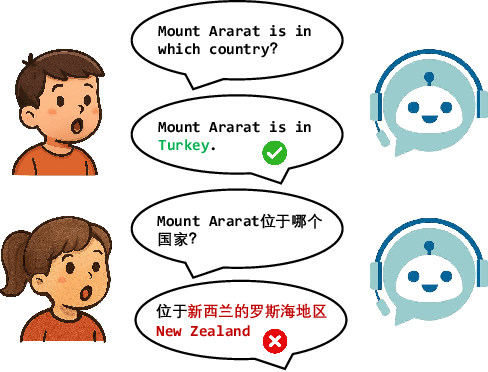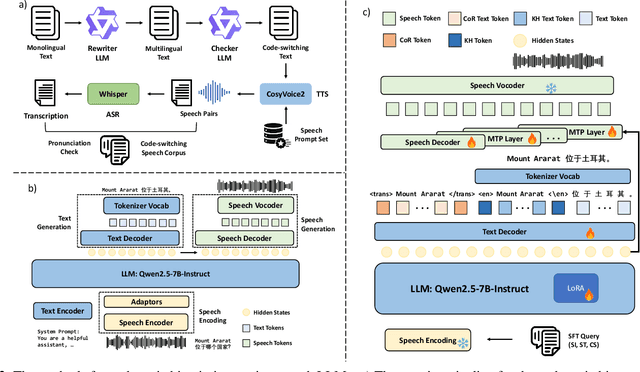speech recognition
Speech recognition is the task of identifying words spoken aloud, analyzing the voice and language, and accurately transcribing the words.
Papers and Code
Multi-Channel Differential ASR for Robust Wearer Speech Recognition on Smart Glasses
Sep 17, 2025With the growing adoption of wearable devices such as smart glasses for AI assistants, wearer speech recognition (WSR) is becoming increasingly critical to next-generation human-computer interfaces. However, in real environments, interference from side-talk speech remains a significant challenge to WSR and may cause accumulated errors for downstream tasks such as natural language processing. In this work, we introduce a novel multi-channel differential automatic speech recognition (ASR) method for robust WSR on smart glasses. The proposed system takes differential inputs from different frontends that complement each other to improve the robustness of WSR, including a beamformer, microphone selection, and a lightweight side-talk detection model. Evaluations on both simulated and real datasets demonstrate that the proposed system outperforms the traditional approach, achieving up to an 18.0% relative reduction in word error rate.
CS3-Bench: Evaluating and Enhancing Speech-to-Speech LLMs for Mandarin-English Code-Switching
Oct 09, 2025



The advancement of multimodal large language models has accelerated the development of speech-to-speech interaction systems. While natural monolingual interaction has been achieved, we find existing models exhibit deficiencies in language alignment. In our proposed Code-Switching Speech-to-Speech Benchmark (CS3-Bench), experiments on 7 mainstream models demonstrate a relative performance drop of up to 66% in knowledge-intensive question answering and varying degrees of misunderstanding in open-ended conversations. Starting from a model with severe performance deterioration, we propose both data constructions and training approaches to improve the language alignment capabilities, specifically employing Chain of Recognition (CoR) to enhance understanding and Keyword Highlighting (KH) to guide generation. Our approach improves the knowledge accuracy from 25.14% to 46.13%, with open-ended understanding rate from 64.5% to 86.5%, and significantly reduces pronunciation errors in the secondary language. CS3-Bench is available at https://huggingface.co/datasets/VocalNet/CS3-Bench.
Thinking in cocktail party: Chain-of-Thought and reinforcement learning for target speaker automatic speech recognition
Sep 19, 2025Target Speaker Automatic Speech Recognition (TS-ASR) aims to transcribe the speech of a specified target speaker from multi-speaker mixtures in cocktail party scenarios. Recent advancement of Large Audio-Language Models (LALMs) has already brought some new insights to TS-ASR. However, significant room for optimization remains for the TS-ASR task within the LALMs architecture. While Chain of Thoughts (CoT) and Reinforcement Learning (RL) have proven effective in certain speech tasks, TS-ASR, which requires the model to deeply comprehend speech signals, differentiate various speakers, and handle overlapping utterances is particularly well-suited to a reasoning-guided approach. Therefore, we propose a novel framework that incorporates CoT and RL training into TS-ASR for performance improvement. A novel CoT dataset of TS-ASR is constructed, and the TS-ASR model is first trained on regular data and then fine-tuned on CoT data. Finally, the model is further trained with RL using selected data to enhance generalized reasoning capabilities. Experiment results demonstrate a significant improvement of TS-ASR performance with CoT and RL training, establishing a state-of-the-art performance compared with previous works of TS-ASR on comparable datasets.
EmoQ: Speech Emotion Recognition via Speech-Aware Q-Former and Large Language Model
Sep 19, 2025The performance of speech emotion recognition (SER) is limited by the insufficient emotion information in unimodal systems and the feature alignment difficulties in multimodal systems. Recently, multimodal large language models (MLLMs) have made progress in SER. However, MLLMs still suffer from hallucination and misclassification problems in complex emotion reasoning. To address these problems, we propose an MLLM-based framework called EmoQ, which generates query embeddings that fuse multimodal information through an EmoQ-Former and uses multi-objective affective learning (MAL) to achieve co-optimization. The framework also provides a soft-prompt injection strategy to inject multimodal representations into the LLM. This end-to-end architecture achieves state-of-the-art performance on the IEMOCAP and MELD datasets, providing a new multimodal fusion paradigm for SER.
Layer-wise Minimal Pair Probing Reveals Contextual Grammatical-Conceptual Hierarchy in Speech Representations
Sep 19, 2025Transformer-based speech language models (SLMs) have significantly improved neural speech recognition and understanding. While existing research has examined how well SLMs encode shallow acoustic and phonetic features, the extent to which SLMs encode nuanced syntactic and conceptual features remains unclear. By drawing parallels with linguistic competence assessments for large language models, this study is the first to systematically evaluate the presence of contextual syntactic and semantic features across SLMs for self-supervised learning (S3M), automatic speech recognition (ASR), speech compression (codec), and as the encoder for auditory large language models (AudioLLMs). Through minimal pair designs and diagnostic feature analysis across 71 tasks spanning diverse linguistic levels, our layer-wise and time-resolved analysis uncovers that 1) all speech encode grammatical features more robustly than conceptual ones.
GLip: A Global-Local Integrated Progressive Framework for Robust Visual Speech Recognition
Sep 19, 2025Visual speech recognition (VSR), also known as lip reading, is the task of recognizing speech from silent video. Despite significant advancements in VSR over recent decades, most existing methods pay limited attention to real-world visual challenges such as illumination variations, occlusions, blurring, and pose changes. To address these challenges, we propose GLip, a Global-Local Integrated Progressive framework designed for robust VSR. GLip is built upon two key insights: (i) learning an initial \textit{coarse} alignment between visual features across varying conditions and corresponding speech content facilitates the subsequent learning of \textit{precise} visual-to-speech mappings in challenging environments; (ii) under adverse conditions, certain local regions (e.g., non-occluded areas) often exhibit more discriminative cues for lip reading than global features. To this end, GLip introduces a dual-path feature extraction architecture that integrates both global and local features within a two-stage progressive learning framework. In the first stage, the model learns to align both global and local visual features with corresponding acoustic speech units using easily accessible audio-visual data, establishing a coarse yet semantically robust foundation. In the second stage, we introduce a Contextual Enhancement Module (CEM) to dynamically integrate local features with relevant global context across both spatial and temporal dimensions, refining the coarse representations into precise visual-speech mappings. Our framework uniquely exploits discriminative local regions through a progressive learning strategy, demonstrating enhanced robustness against various visual challenges and consistently outperforming existing methods on the LRS2 and LRS3 benchmarks. We further validate its effectiveness on a newly introduced challenging Mandarin dataset.
Rethinking Cross-Corpus Speech Emotion Recognition Benchmarking: Are Paralinguistic Pre-Trained Representations Sufficient?
Sep 19, 2025Recent benchmarks evaluating pre-trained models (PTMs) for cross-corpus speech emotion recognition (SER) have overlooked PTM pre-trained for paralinguistic speech processing (PSP), raising concerns about their reliability, since SER is inherently a paralinguistic task. We hypothesize that PSP-focused PTM will perform better in cross-corpus SER settings. To test this, we analyze state-of-the-art PTMs representations including paralinguistic, monolingual, multilingual, and speaker recognition. Our results confirm that TRILLsson (a paralinguistic PTM) outperforms others, reinforcing the need to consider PSP-focused PTMs in cross-corpus SER benchmarks. This study enhances benchmark trustworthiness and guides PTMs evaluations for reliable cross-corpus SER.
BiRQ: Bi-Level Self-Labeling Random Quantization for Self-Supervised Speech Recognition
Sep 18, 2025Speech is a rich signal, and labeled audio-text pairs are costly, making self-supervised learning essential for scalable representation learning. A core challenge in speech SSL is generating pseudo-labels that are both informative and efficient: strong labels, such as those used in HuBERT, improve downstream performance but rely on external encoders and multi-stage pipelines, while efficient methods like BEST-RQ achieve simplicity at the cost of weaker labels. We propose BiRQ, a bilevel SSL framework that combines the efficiency of BEST-RQ with the refinement benefits of HuBERT-style label enhancement. The key idea is to reuse part of the model itself as a pseudo-label generator: intermediate representations are discretized by a random-projection quantizer to produce enhanced labels, while anchoring labels derived directly from the raw input stabilize training and prevent collapse. Training is formulated as an efficient first-order bilevel optimization problem, solved end-to-end with differentiable Gumbel-softmax selection. This design eliminates the need for external label encoders, reduces memory cost, and enables iterative label refinement in an end-to-end fashion. BiRQ consistently improves over BEST-RQ while maintaining low complexity and computational efficiency. We validate our method on various datasets, including 960-hour LibriSpeech, 150-hour AMI meetings and 5,000-hour YODAS, demonstrating consistent gains over BEST-RQ.
PAC: Pronunciation-Aware Contextualized Large Language Model-based Automatic Speech Recognition
Sep 16, 2025



This paper presents a Pronunciation-Aware Contextualized (PAC) framework to address two key challenges in Large Language Model (LLM)-based Automatic Speech Recognition (ASR) systems: effective pronunciation modeling and robust homophone discrimination. Both are essential for raw or long-tail word recognition. The proposed approach adopts a two-stage learning paradigm. First, we introduce a pronunciation-guided context learning method. It employs an interleaved grapheme-phoneme context modeling strategy that incorporates grapheme-only distractors, encouraging the model to leverage phonemic cues for accurate recognition. Then, we propose a pronunciation-discriminative reinforcement learning method with perturbed label sampling to further enhance the model\'s ability to distinguish contextualized homophones. Experimental results on the public English Librispeech and Mandarin AISHELL-1 datasets indicate that PAC: (1) reduces relative Word Error Rate (WER) by 30.2% and 53.8% compared to pre-trained LLM-based ASR models, and (2) achieves 31.8% and 60.5% relative reductions in biased WER for long-tail words compared to strong baselines, respectively.
EMO-RL: Emotion-Rule-Based Reinforcement Learning Enhanced Audio-Language Model for Generalized Speech Emotion Recognition
Sep 19, 2025Although Large Audio-Language Models (LALMs) have exhibited outstanding performance in auditory understanding, their performance in affective computing scenarios, particularly in emotion recognition, reasoning, and subtle sentiment differentiation, remains suboptimal. Recent advances in Reinforcement Learning (RL) have shown promise in improving LALMs' reasoning abilities. However, two critical challenges hinder the direct application of RL techniques to Speech Emotion Recognition (SER) tasks: (1) convergence instability caused by ambiguous emotional boundaries and (2) limited reasoning ability when using relatively small models (e.g., 7B-parameter architectures). To overcome these limitations, we introduce EMO-RL, a novel framework incorporating reinforcement learning with two key innovations: Emotion Similarity-Weighted Reward (ESWR) and Explicit Structured Reasoning (ESR). Built upon pretrained LALMs, our method employs group-relative policy optimization with emotion constraints. Comprehensive experiments demonstrate that our EMO-RL training strategies can significantly enhance the emotional reasoning capabilities of LALMs, attaining state-of-the-art results on both the MELD and IEMOCAP datasets, and cross-dataset experiments prove the strong superiority of generalization.
 Add to Chrome
Add to Chrome Add to Firefox
Add to Firefox Add to Edge
Add to Edge